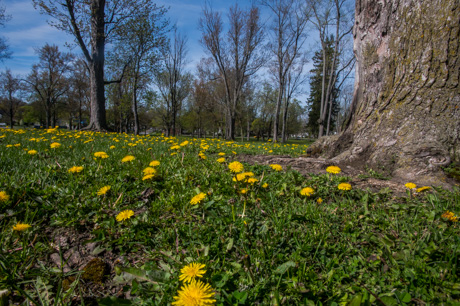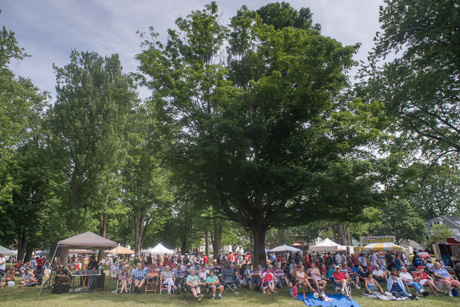
Resiliency is a great attribute for anyone or any place, however, there’s a difference between concept and reality.
New York State and Genesee County officials announced this week a plan to boost the county and its multiple municipalities, including the city’s Centennial Park, with a 454-page resiliency plan. The three-phase strategy for Centennial Park is estimated to cost more than $300,00 once fully completed, plus ongoing maintenance.
“Like with all planning documents, funding is key,” City Manager Rachael Tabelski said. “Otherwise, they sit on a shelf and collect dust.”
The Batavian asked Tabelski about details for the plan, which was unveiled by the state and nonprofit NY Green, and paid for with a $250,000 grant, this week at the base of Centennial Park.
City officials were present but not part of the news conference, though “we did provide information to the consultants about the flood plain and gave permission to Genesee County Planning for the Centennial Park proposed concept, with input from the parkside neighborhood,” Tabelski said.
The proposed concept is a lofty one, aiming to tear out 60 trees, mostly silver maples, and plant 400 new trees and shrubs of more compatible species for a warming environment. Depending on the species, it can take new trees from 15 to 30 years to fully mature.
State Deputy Secretary Kisha Santiago-Martinez said the plan presents a “comprehensive, holistic approach to addressing and preparing for the many challenges we confront in the face of more frequent and severe storm events.”
“By developing and implementing this plan, you are proactively helping to ensure that the county, its municipalities, residents and businesses are better prepared to confront and recover from natural disasters,” she said.
The plan for Centennial, situated in the heart of the city between Ellicott Avenue and State Street, also calls for regrooved pathways and raking autumn leaves up around trees instead of mulching them with a mower. The idea was to reinforce the historic patterns of the park through the use of vegetation, pathways and tree species more akin to this area able to withstand future warming, said David Beatty, an integrally involved Batavia resident who was on the committee to flesh out a park plan.
While Tabelski had no critiques of the plan itself, it comes down to the question, as with most everything: how is it going to be paid for?

Back up to about six years ago, when former City Manager Jason Molino led the formation of a City of Batavia Tree Master Plan in 2017. Consultant Urban Forest Analytics LLC performed the study after several meetings with Public Works, the Bureau of Maintenance, and parks staff. Extensive fieldwork was completed to identify and locate trees as part of the master plan, then-DPW Director Matt Worth said in a memo to Molino.
It was a project of years in the making that included training for proper tree care techniques, risk assessments, maintaining a database, detailed forecasts and strategies, Worth had said.
That plan is followed as funding allows each year for tree removal, planting and pruning throughout the city, including in parks, Tabelski said.
“Trees are an integral part of our city landscape, and fabric of our neighborhoods, not to mention the positive emotional and recreation enhancement trees offer,” she said. “Over the past several years, I have fielded more requests for increased tree planting than any other single request from citizens of the city.”
Highlights of the Tree Master Plan include:
- The number of street trees could increase by 50 percent
- 7 percent of street trees are ash and need to come down (250 trees)
- 15 percent of park trees are in poor condition
- 8 percent of park trees are ash and need to come down (54 trees)
- 38 percent of Batavia has canopy cover
Even though this week’s debuted plan may have seemed to be a given, it is not a mandate, Tabelski said.
“The Genesee County Resiliency Plan includes towns, villages and the city and is purely a road map that communities can choose to follow to make improvements and access grant funds if they so choose,” she said.
As for who will pay for that road map, “the plan that included Centennial Park could be used to apply to grant funds for tree removal and planting, along with the city’s Tree Management Plan.”
“It is a tool to help make informed decisions,” she said. “It is my understanding that the DEC does, periodically, have these types of grants available. The other options are fundraising in the community, corporate sponsors, or through the city’s operating funds.
“This is a planning tool that can help City Council and City Management make future decisions, just like the Tree Management Plan,” she said. “We consult these plans during grant review and budgeting.”
This year’s pending 2023-24 budget for the City of Batavia includes annual tree removal (20 trees) for $26,000, stump removal for $5,500 and tree purchase and replanting (one for one) for $11,600.
Projected costs of future maintenance, if the park plan is completed per the resiliency plan, have not yet been reviewed or evaluated, Tabelski said.
Go here for prior Resiliency Plan coverage.
File Photos of spring, top, and summer, at Centennial Park in Batavia, by Howard Owens.
